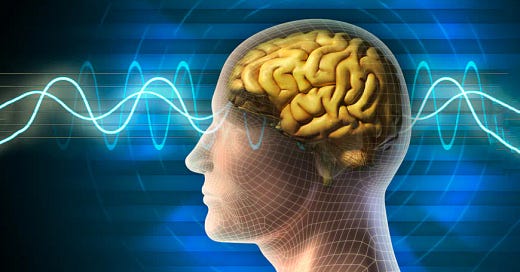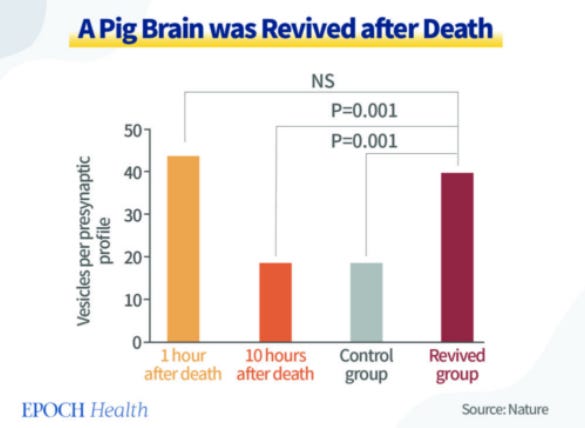Surprising Things Take Place for Some Before Dying
Dying Human Brains May Undergo a Surge of Activity Linked to Consciousness. Some People May Even Be Able to Return From Brain Death
By Mercura Wang @The Epoch Times
Venturing to the brink of death, many people have witnessed extraordinary occurrences, delving into the enigmatic realm of near-death experiences (NDEs).
A 1991 Gallup poll revealed that a striking 5 percent of the adult American population encountered these phenomena.
Fast forward to 2019, and a study involving over 1,000 participants from 35 different countries found that 10 percent of them had also experienced NDEs.
The interplay between dying brains and consciousness continues to captivate researchers worldwide, who ponder the mysteries that lie beyond life’s threshold.
Dying Human Brains May Undergo a Surge of Activity Linked to Consciousness
NDEs can include out-of-body experiences, encountering deceased loved ones, the Almighty, or other spiritual beings, traveling through a tunnel or passage, life review, and feelings of joy and peace. These experiences are extremely lucid, even “realer than real,” as per Jimo Borjigin, who holds a doctorate degree in neurology and who led the research team from the University of Michigan that recently published a study on NDEs in the Proceedings of the National Academy of Science. Their findings shed light on the intriguing relationship between dying brains and consciousness.
The research team analyzed the electroencephalograms (EEG) of four patients dying from cardiac arrest while under EEG monitoring. After the withdrawal of ventilator support, two patients exhibited a rise in heart rate accompanied by a notable surge in gamma wave activity.
Gamma waves, also known as gamma oscillations, are believed to be involved in various cognitive processes and are associated with higher-level brain functions, including attention, perception, memory, and consciousness. Gamma waves may also play a role in coordinating neural activity and information integration across different brain regions.
Moreover, this surge of gamma wave activity was observed within the “hot zone” of neural correlates of consciousness in the brain, situated at the intersection of the temporal, parietal, and occipital lobes at the posterior region. This specific area has been associated with phenomena such as dreaming, visual hallucinations in epilepsy, and altered states of consciousness.
While the two patients had previously experienced seizures, no seizure activity was observed during the hour preceding their deaths. In contrast, the remaining two patients did not exhibit a similar elevation in heart rate upon withdrawal from life support, nor did they demonstrate heightened brain activity.
According to another study published in Frontiers in Neuroscience, NDEs have been linked to heightened synchronization of neuronal activity in the high-frequency range of 13–100 Hz, which plays a role in cognitive functions such as perception, attention, and memory.
Borjigin previously put forward the hypothesis that the process of dying could potentially stimulate specific regions of the human brain, offering a glimpse of consciousness even after the cessation of cardiac activity. And the recent study has provided Borjigin and her colleagues with preliminary evidence that lends support to this hypothesis.
Animal Studies Also Showed Revival of Consciousness in Dying Brains
Similar gamma activations have also been recorded by Borjigin’s team in the dying brains of animals when a loss of oxygen takes place following cardiac arrest.
In a 2013 study, Borjigin and her colleagues discovered that cardiac arrest stimulated a well-organized series of high-frequency EEG events in rats’ dying brains. They concluded that during near-death experiences, there is a temporary and notable synchronization of brain activity in mammals. This study suggests that the mammalian brain has the capacity for heightened internal information processing even during the state of clinical death.
Building upon these findings, in a 2015 study, the team analyzed EEG events in rats’ brains undergoing experimental asphyxia and discovered that suffocation induced a significant and prolonged enhancement in cortical connectivity, accompanied by an increased release of a large number of neurotransmitters until irregular heartbeat occurred. Furthermore, during cardiac arrest, various aspects of cortical activity actually exhibited greater intensity compared to wakeful states.
Asphyxia was also discovered to have the ability to initiate connectivity between the brain and the heart. In advanced stages of suffocation, there was evidence of electrical communication developing between the cerebral cortex and the heart, whereas this connectivity was absent in the early stages. Additionally, as cardiac conditions worsened with a slower heartbeat, the intensity of the electrical communication between the heart and the brain increased.
Researchers further noted a significant increase in the survival time of both the heart and the brain when motor input to the heart was blocked. These findings suggest that directing interventions toward the brain’s outflow could potentially be an effective approach to prolonging the survival of the heart and the brain during asphyxia.
Your Life May Indeed Flash Before Your Eyes When Dying
The NDE phenomenon described by some people as having their life events flashing before their eyes is called “life review” or “life recall.” A 2022 study published in Frontiers in Aging Neuroscience may lend support to this type of occurrence.
The study subject was an 87-year-old patient, who passed away due to a heart attack, while on an EEG device. This is the first study of its kind to measure live brain activity during the process of dying in humans.
Researchers observed that immediately prior to and following the cessation of the patient’s cardiac function, there was an increase of gamma oscillations, which was involved in memory retrieval, as well as alterations in other frequency bands such as delta, theta, alpha, and beta oscillations. In conclusion, they suggested that a dying person might experience glimpses of their life flashing before their eyes.
“These findings challenge our understanding of when exactly life ends and generate important subsequent questions, such as those related to the timing of organ donation,” Dr. Ajmal Zemmar, a neurosurgeon at the University of Louisville and the study’s lead author, said in a press release.
Some People May Even Be Able to Return From Brain Death
In April 2021, 18-year-old Lewis Roberts was declared brain-dead after being hit by a van. His family completed the paperwork to have his organs donated. However, he blinked and started breathing on his own mere hours before his organ donation surgery.
AWARE (AWAreness during REsuscitation), the most extensive medical research ever conducted on the mental state and consciousness during the moments of death, examined 2,060 cardiac arrest cases from 15 American, British, and Austrian hospitals.
According to the four-year study, for humans, there exists a unique experience with death that encompasses a broader scope than NDEs. Among cardiac arrest survivors, it is common for individuals to encounter a wide array of cognitive themes, with approximately 2 percent of the study participants demonstrating complete awareness. These findings suggest the presence of consciousness even in cases where it is clinically imperceptible.
The researchers believe a larger number of individuals may have intense experiences related to death, but they might not recollect them due to the impact of brain injury or the influence of sedative drugs on memory circuits.
“Contrary to perception, death is not a specific moment but a potentially reversible process that occurs after any severe illness or accident causes the heart, lungs and brain to cease functioning,” Dr. Sam Parnia, director of Resuscitation Research at Stony Brook Medicine and the study’s lead author, stated in a press release. “If attempts are made to reverse this process, it is referred to as ‘cardiac arrest’; however, if these attempts do not succeed it is called ‘death.’”
Another study published in Nature demonstrated that the revival of animal brains after death may be feasible. In 2019, in ex vivo conditions, researchers from Yale University were able to sustain the intact microcirculation and cellular functions of pig brains. They achieved this by continuously supplying nutrients and removing metabolic waste, enabling the recovery process to persist for up to six hours.
The findings indicated that a significant number of brain cells remained viable for up to one hour following the pigs’ death, but nearly all of them had perished within 10 hours of death if no resuscitation efforts were made. However, when resuscitation efforts initiated were four hours after the pig’s death, the brain cells became active again for the following six hours. Notably, the count of active brain cells even rebounded to levels comparable to those observed one hour after death.
This suggests that the brain’s tolerance to oxygen deprivation could extend to several hours, rather than the previously assumed timeframe of several minutes.
Possible Causes of Near Death Experiences
“The brain’s hyperexcitability may cause increased neuronal activation as oxygen levels drop after death,” Shara Cohen, who holds a doctorate in immunology, and is the founder and director of Mums in Science, explained in an email to The Epoch Times. “The brain’s attempt to adapt and reject death may also raise consciousness. Near-death experiences and their mechanisms require more research.”
However, other experts believe that near death experiences are proof that the soul may actually exist.
Dannion Brinkley, author of “Saved by the Light,” was electrocuted by lightning in 1975. Immediately afterward, he said felt that his soul left his body and floated in the air while watching his family and friends give him first aid and ambulances take his body to the hospital.
Brinkley’s experience may be related to the soul, according to Dr. Jingduan Yang, a board-certified psychiatrist. It’s hard for some people to believe the presence of souls within human bodies,, he said. One reason why is that the soul is “so microscopic” that current science and technology cannot detect it.
The increased brain activities in the dying brain in the University of Michigan study may be “associated with the activity of souls that are leaving the dying body,” he added. “because gamma activities are associated with human consciousness.”
“Of course, nobody knows for sure, but the hypothesis sounds plausible to me,” Yang said.
The AWARE study also discovered that in certain instances of cardiac arrest, individuals may retain memories of visual awareness that align with out-of-body experiences, and these memories may even correspond with real-life events.
The exploration of consciousness and the state of the human mind during the time of death is a highly intricate endeavor. Continued research and study in this field are crucial for unraveling the mysteries surrounding death and shedding light on the nature of human consciousness.
If you appreciate our content, please consider making a donation --
GiveSendGo - Help Support Tuzara Post Newsletter: The #1 Free Christian Fundraising Site.





